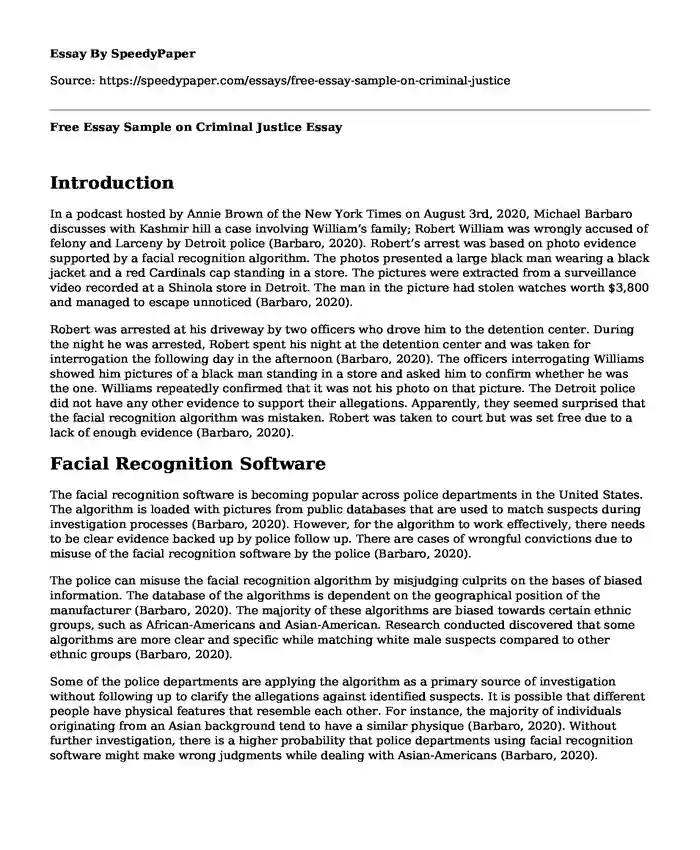
| Type of paper: | Essay |
| Categories: | Law Criminal justice |
| Pages: | 3 |
| Wordcount: | 604 words |
Introduction
In a podcast hosted by Annie Brown of the New York Times on August 3rd, 2020, Michael Barbaro discusses with Kashmir hill a case involving William’s family; Robert William was wrongly accused of felony and Larceny by Detroit police (Barbaro, 2020). Robert’s arrest was based on photo evidence supported by a facial recognition algorithm. The photos presented a large black man wearing a black jacket and a red Cardinals cap standing in a store. The pictures were extracted from a surveillance video recorded at a Shinola store in Detroit. The man in the picture had stolen watches worth $3,800 and managed to escape unnoticed (Barbaro, 2020).
Robert was arrested at his driveway by two officers who drove him to the detention center. During the night he was arrested, Robert spent his night at the detention center and was taken for interrogation the following day in the afternoon (Barbaro, 2020). The officers interrogating Williams showed him pictures of a black man standing in a store and asked him to confirm whether he was the one. Williams repeatedly confirmed that it was not his photo on that picture. The Detroit police did not have any other evidence to support their allegations. Apparently, they seemed surprised that the facial recognition algorithm was mistaken. Robert was taken to court but was set free due to a lack of enough evidence (Barbaro, 2020).
Facial Recognition Software
The facial recognition software is becoming popular across police departments in the United States. The algorithm is loaded with pictures from public databases that are used to match suspects during investigation processes (Barbaro, 2020). However, for the algorithm to work effectively, there needs to be clear evidence backed up by police follow up. There are cases of wrongful convictions due to misuse of the facial recognition software by the police (Barbaro, 2020).
The police can misuse the facial recognition algorithm by misjudging culprits on the bases of biased information. The database of the algorithms is dependent on the geographical position of the manufacturer (Barbaro, 2020). The majority of these algorithms are biased towards certain ethnic groups, such as African-Americans and Asian-American. Research conducted discovered that some algorithms are more clear and specific while matching white male suspects compared to other ethnic groups (Barbaro, 2020).
Some of the police departments are applying the algorithm as a primary source of investigation without following up to clarify the allegations against identified suspects. It is possible that different people have physical features that resemble each other. For instance, the majority of individuals originating from an Asian background tend to have a similar physique (Barbaro, 2020). Without further investigation, there is a higher probability that police departments using facial recognition software might make wrong judgments while dealing with Asian-Americans (Barbaro, 2020).
Conclusion
In regards to Robert Williams’s case, it is evident that facial recognition algorithms can lead to wrong convictions if not used appropriately. Clearly, the information derived from the software has a great impact on the life of individuals in question. Thus, police departments could adapt using a common algorithm originating from a reliable manufacturer. The national police department can work hand in hand with the manufacturer to ensure the software meets the required standards. The act can help to eliminate the risk of biasness posed by the use of facial recognition systems. Additionally, the police departments should adhere to the required protocols of investigation rather than using the algorithm as a primary source of evidence. However, facial recognition software is reliable in ensuring justice is served if used accordingly.
Reference
Barbaro, M. (2020, August 3). Wrongfully Accused by an Algorithm. The New York Times. https://www.nytimes.com/2020/08/03/podcasts/the-daily/algorithmic-justice-racism.html.
Cite this page
Free Essay Sample on Criminal Justice. (2023, Dec 25). Retrieved from https://speedypaper.com/essays/free-essay-sample-on-criminal-justice
Request Removal
If you are the original author of this essay and no longer wish to have it published on the SpeedyPaper website, please click below to request its removal:
- The Case of Freddie Gray - Police Brutality Paper Sample
- Free Essay about the United Nations Human Rights Council
- Essay Sample on Black Lives Matter: Police Brutality against Black Community in the USA
- Discussion Essay Sample of the Issue of Prison and Incarceration in the United States
- Roper v. Simmons - Free Essay on Juvenile Justice and Delinquency
- Free Essay. Introduction to Victimology
- Free Essay: Advocacy for English Language Learners Students
Popular categories




